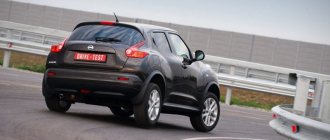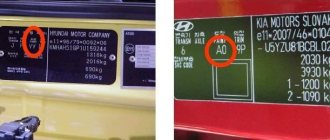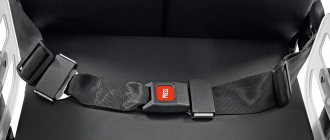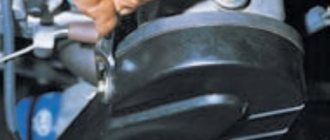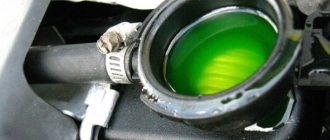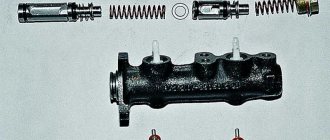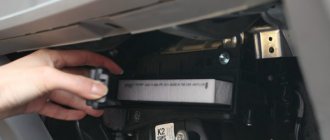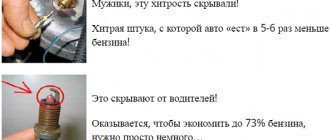For those who have recently gotten behind the wheel or are just planning to do so and are taking driving lessons, we will tell you and show you on video how to properly park in reverse. Reverse parking for beginners is most safely practiced at a race track. Parallel parking in reverse involves placing a car between two cars parked on the roadway parallel to the curb at a sufficient distance from each other. Learning this, as you understand, should begin with theory. Driving lessons, theory and watching videos, of course, cannot be replaced, but these are mandatory steps in mastering the technique. In addition, the training will not go any worse if you are at least familiar with the layout of the entrance to the garage. Perpendicular parking lessons are easier for cadets, so let's start with it.
Reverse parking perpendicular to the curb
Turn the wheels when you stop.
1. Move in the middle of the corridor
2. Drive forward so that the tail of your car is level with the side of the car you need to go around.
3. From this point, we begin to twist the steering wheel in the direction of the turn - all the way (the wheels will be turned as far as possible), and engage reverse gear.
4. Then you need to drive slowly back and stop when the car is parallel to neighboring cars. When turning, the car passes near the tailgate of someone else's car.
5. At this point, standing still, turn the steering wheel so as to set the wheels straight. 6. Then, on straight wheels, drive inside to the curb.
Error correction
If the starting position was chosen incorrectly, and the car is driving in such a way that it can hit someone else’s car (near, far car or car from the opposite side):
stop, set the wheels straight and
- when approaching a nearby car , continue to move back straight until your rear wheels are level with the corner of the other car: Then the driving pattern is the same as at first - turn the steering wheel all the way, move back until parallel, etc.
- When approaching a distant car, drive forward and then proceed according to the basic scheme (as at first).
- when approaching a car from the opposite direction
The car is parked too close
4 step rule: 3 steps forward and 1 step back
1. With the steering wheel fully unscrewed, drive 1 m to the side. 2. Turn the steering wheel to set the wheels straight (count the steering wheel revolutions). Drive forward 3-4 m on straight wheels
3. Turn the steering wheel in the opposite direction and drive forward until it is parallel to someone else’s car. In this case, you can navigate by mirrors.
4. The last step is to move BACKWARDS on straight wheels.
(https://youtu.be/6x3C4krSwwo)
How to park in reverse?
It is rightly said that mastery is a matter of experience. However, it is not the only one that is the main criterion. It is also important to know the theory, thanks to which you can predict many controversial issues. Every driver, when getting behind the wheel of a car, must know the rules of the road, how to move correctly so as not to create emergency situations, as well as maneuver, make turns and park the car.
Before you start parking in reverse, you should make sure that the mirrors have the correct settings, namely, the side and rear areas should be clearly visible in them. In this case, the inner part should be directed to the side of the car, and the rest should cover the travel area behind the car.
Good to know! If there is a high curb at the edge of the roadway, drivers can use the right mirror as a regulator, thus preventing damage to the wheels or vehicle.
Reverse parking is divided into:
- Parallel.
- Perpendicular.
Parallel parking in reverse - diagram
If there are no parking spaces, then drivers can park the car along the curb, one after another. This is a very common option, especially in large cities. This option involves parallel parking, but it is important to understand that it must be done only in reverse, otherwise “at a distance of 50 cm, so that it is convenient for the driver to maneuver without interfering with others.
If the manager does not have enough experience, it is better to make a stop parallel to the front car, with a lateral distance of 60 cm from it, stretch 10 cm to the left, so that the front part is slightly to the left of the rear part.
Let's celebrate! Before maneuvering, the driver must be sure that he is not creating an emergency situation. Having taken the required position, the steering wheel turns to the right, a slow move begins, so as to maintain an optimal distance relative to other cars.
Driving with the steering wheel turned to the right will continue until the rear part occupies, occupies the left rear corner so that the right headlight behind the parked car is visible in the mirror.
Then, you need to turn the steering wheel straight, and, focusing on the view in the mirrors, park until the vehicle takes a position in which the front right corner is visible.
After this, you need to turn the steering wheel as far as possible to the left and take the required position in the parking space.
Perpendicular parking in reverse - diagram
When parking perpendicularly, it is supposed to maintain a distance of 50 cm between other cars so that it does not become difficult to open the doors of other parked cars.
Reversing when parking perpendicularly is carried out carefully until the car approaches the parking space.
Then, you need to stop so that the luggage area is perpendicular to the other car at a distance of 50 cm. Then you need to carefully turn the steering wheel to the left, and, focusing on the left mirror, slowly move back, maintaining the required distance between other participants.
After the car takes the required position, you need to align it to its original position and complete the maneuver. If necessary, the distance between cars can be adjusted.
Lifehacks and advice from professionals
To hone your driving skills, it is important to rely on the advice of experienced specialists. Before performing any maneuver, care should always be taken to ensure that the driver's intentions are clear to other road users. For example, after stopping to park parallel to other vehicles, you need to immediately engage reverse gear.
Reversing lights will indicate your intention to move in a certain direction. After this, you need to look around, expanding your visibility area as much as possible. When driving, look over your right shoulder and drive until the vehicle is at a 45-degree angle to the curb.
From outside your vehicle, you can define an imaginary line that will be easy to follow when performing a maneuver. It should connect the rear wheel of the other car and a point on the right rear window visible from the driver's seat. When parking, you can use the mark on the window to clearly see where the rear wheels are at a certain moment.
After reaching a certain level of skill, when parking, it is better to turn the steering wheel without first stopping. This will not only speed up the maneuver itself, but will also extend the life of the steering mechanisms.
On the other hand, when reversing, it is recommended to periodically open the door and monitor the actual distance to parked vehicles.
If sufficient skills have not been developed, it is recommended to use the help of another person outside the car.
Most often, mistakes made by novice drivers are caused by uncertainty and a stressful situation. To control any traffic situation, you need to memorize a clear algorithm of actions when performing parallel parking.
Every driver should be able to park well. Some people acquire this important skill while studying at a driving school, but not everyone can say that they can reverse park correctly after receiving a driver's license. One of the most intimidating maneuvers for beginners is parallel parking. This, as well as other parking methods, will be discussed in today’s article.
The ability to confidently park your car in reverse will definitely come in handy. It’s difficult to even imagine how to drive a car in a big city, and not only in a big city, without knowing how to perform this procedure. Of course, few people manage to immediately become a parking master; practice is very important in this matter. But first you need to clearly understand how to act in a given situation.
We will look at several ways to reverse park between two cars.
Parallel parking technique
To begin, the examinee must drive up to the “Start” line, which is located level with the simulated car in front. After this, you need to drive into the gap between these two cars and then stop. As you might have guessed, the method of entering the parking zone is not regulated, but this can only be done by reversing, so the candidate has no other way. At the same time, there are some restrictions that relate to the fact that errors cannot be corrected by driving forward. This means that only moving backwards is allowed, and how to do it correctly is usually taught by the instructor
What can you get penalty points for? The list is given below:
- Knocked down post or crossing the boundary lines of a parking zone - 5 points
- Uneven vehicle positioning. Typically, this applies to the fact that after completing the exercise, the machine goes beyond the dotted line indicating the lateral interval - 5 points
- The engine stalled or the exercise was completed in two reverse gear engagements. For example, if you feel that you don’t fit in and turn on first to move forward, then you will be given 3 penalty points for this.
- In addition, you can get penalty points for not switching off the reverse gear after stopping, as well as if you forget to put the parking brake on the car (3 points each).
Parking
Before you begin the maneuver, you must ensure that all mirrors are adjusted correctly. The following areas should be visible in them:
- behind the driver;
- On the sides.
Also, the inside of the side mirror should reflect the side of the car, and the rest of the area should reflect the roadway. After this you can start parking.
Parking between cars in front can be:
- Parallel.
- Perpendicular.
Each option should be considered separately.
Parallel
It is considered one of the most popular methods, since drivers often leave their cars along the road, next to the curb. In this case, the cars line up in a so-called line. Therefore, the owner of a car that needs to stop somewhere for a long time has to resort to parallel parking.
The sequence of actions for parallel parking is as follows:
- First, the driver needs to decide on a suitable place to park the car. To do this, you need to slow down and slowly move along the vehicles in search of free space. It is worth considering that the planned parking place must have the dimensions of the car so that it can enter and not interfere with the flow of cars on the roadway.
- After you have found a place, you should drive a little and stop a little in front of the parked car. In this case, the vehicle of the driver who plans to park must be parked parallel, and the distance between cars in the parking lot should not exceed 60 cm. It is also important before stopping to pull the car a little to the left so that its front part is slightly away from the rear part.
- Finally, you can start maneuvering in reverse. Before driving, the driver should make sure that there are no cars in the rearview mirror. Only in this case can the maneuver be considered safe. If a car is moving behind you, you first need to let it pass. Additionally, it is worth checking that the rear left corner of the already parked car is visible in the right side mirror.
- Then you can steer the wheel to the right and slowly start moving without taking your eyes off the mirror.
- You need to drive with the steering wheel turned out until the rear of the car reaches the left rear corner of the parked vehicle. When the headlight of the car behind appears in the left side mirror, you can proceed to the next maneuver.
- When performing a new maneuver, you must return the steering wheel to its original position, make sure that the wheels are parallel to the car, and slowly begin to move backwards, observing the position of the vehicle in the mirrors.
- You should stop moving when you can’t see part of the parked car in the mirror, which you initially took as a guide. At this moment, you will need to turn the steering wheel as far as possible to the left and resume moving backwards again.
The final result will be the car parking between two vehicles. If the instructions were followed correctly, the machine will stand parallel.
Perpendicular
Basically, car owners use this method when parking:
- inside courtyards;
- in parking lots;
- in the parking lot next to the store.
To perform perpendicular parking, you must:
- Decide on a parking spot. At the same time, in the process of choosing a place, you need to take care of the dimensions of the car and take into account that there is more than 40 cm between two cars due to parking, otherwise it will not be possible to get out of the vehicle.
- Next, you need to reduce your speed and move perpendicularly along the cars. When the parking area is reached, you will need to drive forward a little.
- After this, you need to stop the car and turn the steering wheel to the maximum to the left. Before you begin the maneuver, you need to make sure that there are no cars or any obstacles behind.
- The next action will be to start reversing. You need to move slowly and additionally focus on the left side mirror. The driver also needs to maintain the distance mentioned above.
- After a few seconds, the car will stand parallel to the parked cars, and then the driver needs to stop and return the steering wheel to its previous position.
At this stage, the maneuver is considered completed. After this, you can turn off the engine and raise the handbrake. If necessary, the position of the car can be adjusted.
Step-by-step instructions for parallel parking
Constantly honing driving skills and abilities makes driving easier and increases the safety of movement in the busy city rhythm. It is important to focus on both moving and stopping.
At the race track
Following proven technology during the training process teaches you to focus on certain signs that help you perform various maneuvers confidently, quickly and safely. The parallel method of parking a car using the mirrors ensures the successful completion of this task even by inexperienced car enthusiasts if they strictly adhere to the step-by-step instructions.
Parallel parking at the motorway
It is important to follow it by performing the following sequential actions on the racetrack:
- Drive the car to the line marked “Start” and stop it there. According to traffic police regulations, a certain time is allotted for completing each specific task, so you should start driving only when you are fully prepared.
- Preparation involves adjusting the outside rear view mirror on the right side. It should be set so that the road surface at the level of the rear wheels is clearly visible. After this, you can start moving to the outermost chip, indicating the left rear corner of the vehicle in front.
General Tips
— Correct adjustment of mirrors: The outside rear view mirrors should be turned far outward so that the blind angle is as small as possible. The car body must be visible in the mirrors. Ideally, you should be able to see the car's rear door handles through your side mirrors. In the interior rearview mirror, you should be able to see the rear window as much as possible.
— Calculation of distances: The parking space you choose should be large enough so that when you park your car you will not hit other vehicles. You should also take into account that in order to get out of the car, you need space around the car so as not to hit another car with the door. In particular, always think about how the driver will get into the car standing next to you. But don't rely on your car's parking sensors or rearview camera when parking. Park using your mirrors. - No panic and stress! Of course, parking in reverse takes time. The first rule is not to rush. As they say, if you hurry, you will make people laugh. If other cars are following you, don't worry. Don't let other road users rush you, drive slowly. Vanity will not lead to anything good. If parking fails the first time, start again. At this point, other road users must understand that if they rush you, they will wait even longer. This is the only way to avoid an accident when parking. If you are nervous and fussy, you will increase the risk of hitting other cars while parking.
Parallel parking is part of the driver's license test. During training, each driving school student goes through this type of reverse parking with a driving instructor. Unfortunately, we may rarely use parallel parking in our daily lives. Therefore, even if you easily coped with this type of parking in a driving school and successfully passed your license exams, it does not mean that you will now easily and simply park backwards all your life. After all, if you rarely perform any maneuvers while driving, you lose your skill.
See also: How to accidentally avoid getting into a paid parking zone
As a result, even for experienced drivers, sometimes parallel parking becomes a nerve-wracking experience. So if you are not confident in your knowledge and experience, you should practice parallel parking on a regular basis. The more you try to park backwards, the more experience and confidence you will have. For example, on weekends, you can get up early in the morning and drive to an empty parking lot near a shopping center or supermarket to practice or improve your reverse parking skills in a calm environment. This way you will learn to better feel your car, its dimensions, and also free yourself from the fear of parallel parking.
What is parallel parking and why is it needed?
This action is one of the most difficult driving maneuvers, since it is performed in reverse in the confined space of crowded city streets. When performing it, you need to carefully “squeeze” the car into a pocket between the cars parked along the road on one side. Such parking is especially important on narrow road arteries, since this leaves the possibility of passage for other vehicles.
Often, incorrectly parked cars are the cause of accidents. When parking a car, it is important to calculate the space in such a way that it is convenient for all drivers to leave later. To facilitate this task, in some cases markings are applied. For everyday city driving, standard requirements must be taken into account.
The longitudinal dimensions of the parking space must be twice the length of the car, and the transverse dimensions must be 1 m greater than the width of the car.
After parking is completed, it is recommended to get out of the car, check the allowable distances and, if necessary, level it. Such norms are provided for by legislative acts, which are contained in the “Code of Administrative Offenses of the Russian Federation”. If they are ignored according to the Code of Administrative Offences, Art. 12.19 provides for a fine of 500 to 5000 rubles.
Parallel parking in front.
So let's get started. At first glance, if you pull into the parking lot from the front, then everything is simple - just pick it up and drive in. But this opinion is wrong - if the front of the car is in the right place, then the tail sticks out on the road. If the size of the parking space is 2 cars, then you can do the following.
We need to drive straight and drive onto the curb with our front wheels and with further movement we pull our tail of the car towards the curb, then sharply turn the steering wheel so that the front end jumps back onto the road and in the end we stand parallel to the curb. A distance equal to the length of two cars is the minimum distance for parking in front. But this option, with hitting the curb, is not entirely ethical, and sometimes dangerous for the car’s suspension.
Now the second option, civilized, without hitting the curb. We move, work the steering wheel, stretch the front of the car along the curb. The tail of the car is pulled up to the curb extremely reluctantly and a considerable distance is required for our car to completely press against the edge of the road and stand parallel to the curb. This maneuver will require a distance equal to the length of three cars.
Conclusion - to drive ahead, you need a distance of three cars, and with a collision with a curb, at least two.
What if there is no such distance and it is smaller, or we don’t want to jump on the curb?
Parallel parking in urban environments
Of course, this technique is rarely performed in areas with busy traffic, because driving in reverse can create interference for others. Therefore, many drivers try to drive into such a pocket in front, which, naturally, they fail. In this case, the length of such a pocket should be at least 1.5-1.6 times the length of the machine.
Another problem is the different distance between parked cars . During driving lessons, such skills are practiced on sites built in accordance with GOST, but in real life these pockets may be different. Therefore, in this situation it is better to carefully look in the mirrors or resort to the help of others.
